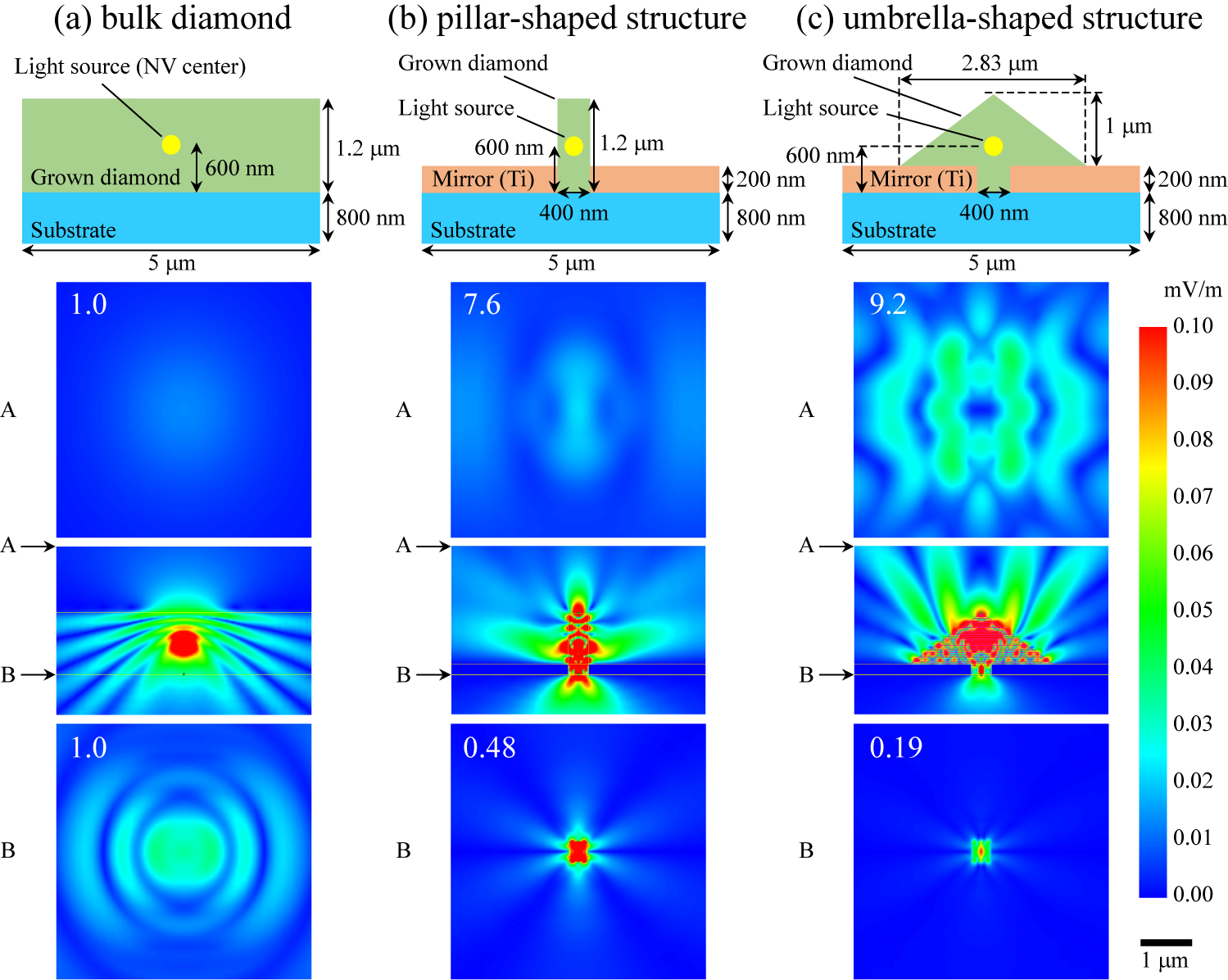Tiny, luminescent nanostructures may prove to be useful in highly sensitive magnetic sensors or within the realm of quantum computing.
From the Journal: Applied Physics Letters
WASHINGTON, D.C., October 20, 2015 – Standard umbrellas come out when the sky turns dark, but in the nanoworld, umbrella shapes may be the next creative way to enhance light emission. Inspired by recent work to enhance the luminescence from diamond nanopillar structures, a team of researchers in Japan has discovered that “umbrella-shaped” diamond nanostructures with metal mirrors on the bottom are more efficient photon collectors than their diamond nanostructure “cousins” of other shapes.
By tweaking the shape of the diamond nanostructures into the form of tiny umbrellas, researchers from Tokyo Institute of Technology experimentally showed that the fluorescence intensity of their structures was three to five times greater than that of bulk diamond. They report their results in the journal Applied Physics Letters, from AIP Publishing.
To get started, the team formed the umbrella-shaped diamond nanostructures by using an original “bottom-up” fabrication technique that relies on selective and anisotropic growth through holes in a metal mask. The metal mask also serves as a mirror that is self-aligned to the diamond nanostructures.
“Our umbrella-shaped nanostructure has an effect similar to a solid immersion lens, which reduces the chance of total reflection on its upper surface and focuses the emitted light toward the ‘upside’ of the structure,” explained Mutsuko Hatano, a professor in the Graduate School of Science and Engineering’s Department of Physical Electronics at Tokyo Institute of Technology.
The self-aligned mirror goes a step further to enhance the efficiency of collecting this light by reflecting it at the lower surface area of the nanostructure.
“Umbrella-shaped diamond provides significantly better photon collection efficiency than bulk diamond or its pillar-shaped diamond counterpart, which have already been studied extensively,” Hatano noted.
The significance of the team’s discovery is that they’ve shown that the brighter fluorescence intensity of umbrella-shaped diamond nanostructures can be achieved by improving the photon collection efficiency of the nitrogen vacancy centers, which are the numerous point defects in diamonds that happen to boast the property of photoluminescence.
These nitrogen vacancy centers possess unique properties such as optical initialization and detection of its spin states, stable and strong fluorescence even from a single center, and long spin coherence time at room temperature. These properties make nitrogen vacancy centers in diamonds candidates for next-generation spin-based quantum devices such as magnetometers, quantum computers, and for research or work involving biological observations. Individual nitrogen vacancy centers could essentially function as the basic units of quantum computers.
Brighter fluorescence intensity is an essential aspect of improving the photon collection efficiency from nitrogen vacancy centers. Due to the high refractive index (2.4) of diamond, the photon collection efficiency from the nitrogen vacancy centers in bulk diamond is low. “In other words, diamond works as an effective light waveguide in low-refractive-index environments,” said Hatano.
In terms of applications, the team’s nanostructures may find use in highly sensitive magnetic sensors for making biological observations or within the computational science realm for quantum computing and cryptographic communications.
Next, Hatano and colleagues plan to pursue better control of the nanostructures’ shape, as well as target a smoother surface by optimizing chemical vapor deposition growth conditions.
“Our goal now is to improve the nanostructures’ photon collection efficiency,” she said. “We also plan to demonstrate quantum sensors — in particular, highly sensitive magnetometers intended for life science and medical applications.”
This work was supported by CREST, Japan Science and Technology Agency.
###
For More Information:
Jason Socrates Bardi
jbardi@aip.org
240-535-4954
@jasonbardi
Article Title
Authors
S. Furuyama, K. Tahara, T. Iwasaki, M. Shimizu, J. Yaita, M. Kondo, T. Kodera and M. Hatano
Author Affiliations
Tokyo Institute of Technology and Japan Science and Technology Agency
